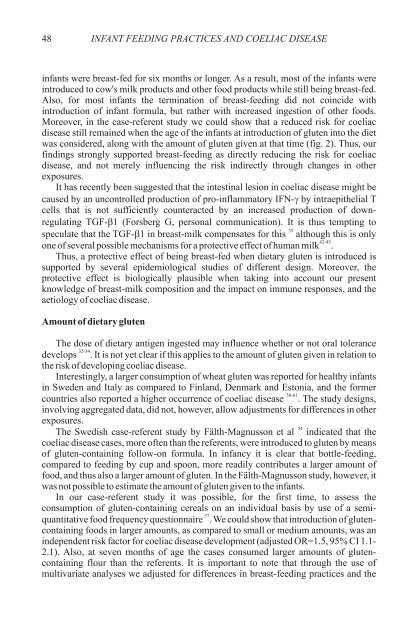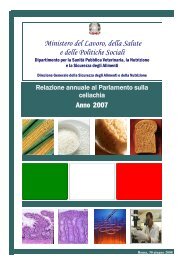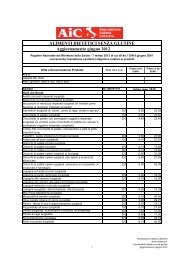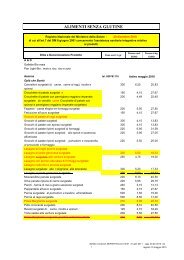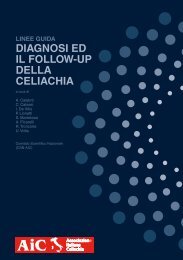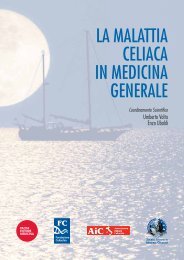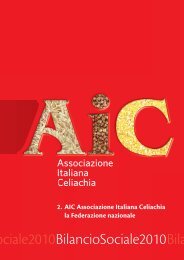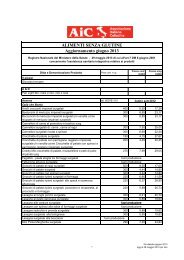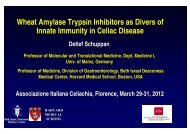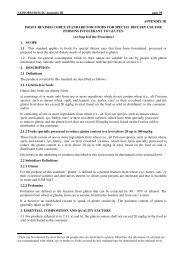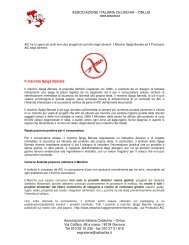primary prevention of coeliac disease - Associazione Italiana ...
primary prevention of coeliac disease - Associazione Italiana ...
primary prevention of coeliac disease - Associazione Italiana ...
You also want an ePaper? Increase the reach of your titles
YUMPU automatically turns print PDFs into web optimized ePapers that Google loves.
48 INFANT FEEDING PRACTICES AND COELIAC DISEASE<br />
infants were breast-fed for six months or longer. As a result, most <strong>of</strong> the infants were<br />
introduced to cow's milk products and other food products while still being breast-fed.<br />
Also, for most infants the termination <strong>of</strong> breast-feeding did not coincide with<br />
introduction <strong>of</strong> infant formula, but rather with increased ingestion <strong>of</strong> other foods.<br />
Moreover, in the case-referent study we could show that a reduced risk for <strong>coeliac</strong><br />
<strong>disease</strong> still remained when the age <strong>of</strong> the infants at introduction <strong>of</strong> gluten into the diet<br />
was considered, along with the amount <strong>of</strong> gluten given at that time (fig. 2). Thus, our<br />
findings strongly supported breast-feeding as directly reducing the risk for <strong>coeliac</strong><br />
<strong>disease</strong>, and not merely influencing the risk indirectly through changes in other<br />
exposures.<br />
It has recently been suggested that the intestinal lesion in <strong>coeliac</strong> <strong>disease</strong> might be<br />
caused by an uncontrolled production <strong>of</strong> pro-inflammatory IFN-gby intraepithelial T<br />
cells that is not sufficiently counteracted by an increased production <strong>of</strong> downregulating<br />
TGF-b1 (Forsberg G, personal communication). It is thus tempting to<br />
35<br />
speculate that the TGF-b1 in breast-milk compensates for this although this is only<br />
42-45<br />
one <strong>of</strong> several possible mechanisms for a protective effect <strong>of</strong> human milk .<br />
Thus, a protective effect <strong>of</strong> being breast-fed when dietary gluten is introduced is<br />
supported by several epidemiological studies <strong>of</strong> different design. Moreover, the<br />
protective effect is biologically plausible when taking into account our present<br />
knowledge <strong>of</strong> breast-milk composition and the impact on immune responses, and the<br />
aetiology <strong>of</strong> <strong>coeliac</strong> <strong>disease</strong>.<br />
Amount <strong>of</strong> dietary gluten<br />
The dose <strong>of</strong> dietary antigen ingested may influence whether or not oral tolerance<br />
32-34<br />
develops . It is not yet clear if this applies to the amount <strong>of</strong> gluten given in relation to<br />
the risk <strong>of</strong> developing <strong>coeliac</strong> <strong>disease</strong>.<br />
Interestingly, a larger consumption <strong>of</strong> wheat gluten was reported for healthy infants<br />
in Sweden and Italy as compared to Finland, Denmark and Estonia, and the former<br />
58-61<br />
countries also reported a higher occurrence <strong>of</strong> <strong>coeliac</strong> <strong>disease</strong> . The study designs,<br />
involving aggregated data, did not, however, allow adjustments for differences in other<br />
exposures.<br />
54<br />
The Swedish case-referent study by Fälth-Magnusson et al indicated that the<br />
<strong>coeliac</strong> <strong>disease</strong> cases, more <strong>of</strong>ten than the referents, were introduced to gluten by means<br />
<strong>of</strong> gluten-containing follow-on formula. In infancy it is clear that bottle-feeding,<br />
compared to feeding by cup and spoon, more readily contributes a larger amount <strong>of</strong><br />
food, and thus also a larger amount <strong>of</strong> gluten. In the Fälth-Magnusson study, however, it<br />
was not possible to estimate the amount <strong>of</strong> gluten given to the infants.<br />
In our case-referent study it was possible, for the first time, to assess the<br />
consumption <strong>of</strong> gluten-containing cereals on an individual basis by use <strong>of</strong> a semi-<br />
57<br />
quantitative food frequency questionnaire . We could show that introduction <strong>of</strong> glutencontaining<br />
foods in larger amounts, as compared to small or medium amounts, was an<br />
independent risk factor for <strong>coeliac</strong> <strong>disease</strong> development (adjusted OR=1.5, 95% CI 1.1-<br />
2.1). Also, at seven months <strong>of</strong> age the cases consumed larger amounts <strong>of</strong> glutencontaining<br />
flour than the referents. It is important to note that through the use <strong>of</strong><br />
multivariate analyses we adjusted for differences in breast-feeding practices and the


